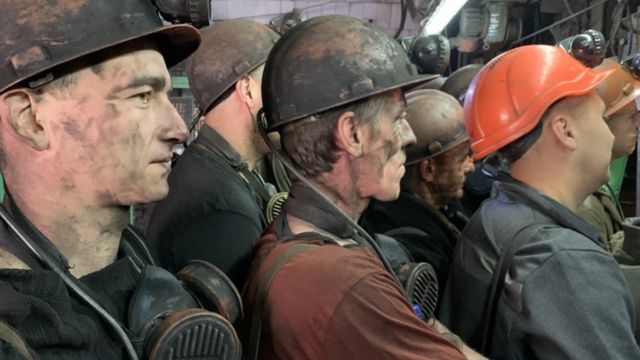- Andrew Harding
- BBC News, Toretsk, Ukraine

Imagine you are a miner going down into a deep, old and shaky mine well.
Now imagine that you are doing this in a combat zone.
“It’s scary, but what can you do? We don’t have many options,” said Ira Yusko, a 30-year-old Ukrainian nurse, smiling grimly as she turned on a headlight at the Toretska coal mine in Donbas.
Around her, more than a dozen miners – with their faces already covered in mud – walk in the dark to an iron elevator that rattles, waiting to pick up a group 800 meters underground for a six-hour shift.
“We try to be positive. But it’s hard on the soul. It’s depressing. It’s a terrible time. Home is also sad – there is no wife,” says Vitaly Vahorder. He spent half of his life at the Toretsk mine. His family recently traveled west to safer places.
Outside, the roar and crunch of artillery fire echoes through the wheat fields from the front line, 4 km southeast, where Russian troops are trying to gain ground in the face of fierce Ukrainian resistance.
“People go down to the mine, knowing they can’t get up. And when they do, anything can happen – the city is constantly bombed,” said Anatoly Sholokhov, deputy head of the Toretsk Miners’ Association, watching the elevator doors close. The 69-year-old miner was born in the city and was once its mayor.
After many years of war, most of the mines in eastern Ukraine were forced to close
Coal mines with heaps rising on the horizon like dark pyramids have been a defining feature of Eastern Ukraine for over a century. They provided the Russian Empire, and then the Soviet Union, with most of its energy resources. But the collapse of the Soviet Union in 1991, the last eight years of separatist conflict with pro-Russian militias and a new Kremlin offensive together have forced most mines to close.
One of the many problems today is that recent mine closures are sudden and without proper safety measures, flooding old mines with highly toxic water that threatens to poison local rivers.
“The danger comes when several mines stop at the same time,” says Anatoly. “You can’t control where the groundwater gets. If it comes to the surface, there will be a catastrophe. May God not allow these mines to stop. If work stops and water starts flooding the mines, it could lead to disaster. ”
Here, in Toretsk, there are still only two mines – one of them was formerly named Dzerzhinsky in honor of the founder of the Communist Secret Police.
When you drive from the west, past the Ukrainian army checkpoints, to an almost empty city with its architecture and Soviet-era monuments, you seem to be in the past. The Soviet red star still hangs on top of one of the oldest towers in the Toretsk mine, which first began mining in the 1930s and was badly damaged during World War II. The mine does not appear to have improved since the last renovation in 1955.
One sunny morning last week, the staff conducted a tour here for visitors. Giant rusty mechanisms stand near the winding railway track, where a lone worker manually pushes mine carts to a wooden barn. Two giant slags behind the mine are partially covered with trees and undergrowth. A huge tree sprouted through one old drum wheel. Boards creak ominously overhead as workers walk across the bridge from the mine back to the shower block – there is currently no water there, as in the rest of the city, due to a blockade on a nearby canal due to the war.
Only a third of the mine’s personnel have remained since the beginning of the Russian offensive
“There is no water anywhere in this city. You go to the toilet – but how to flush? When it rains, everyone in our house goes out to collect rainwater,” says Vitaly.
Since the start of the Russian offensive earlier this year, only a third of the mine’s staff has remained in the city, some due to loyalty to the mine itself, but mostly for financial reasons.
“I’ve been working here for twenty years. After school I went straight to the mine. There are no other professions here. There are no factories. We earn from 8,000 to 10,000 hryvnias a month, and at current prices it’s nothing, a trifle, no better than a student scholarship, “says Yuri Podlutsky.
In general, the miners did not seem to want to evaluate the war or Putin directly. Many of them are Russian-speaking and seem to seek to avoid topics that could cause controversy in a cohesive community. But several men admitted to a strong nostalgia for the Soviet era and the times when Ukrainians and Russians worked side by side in the mines.
“Whether you like Putin or not, we still have to live and work. There are a lot of ‘councils,'” says Vitaly.
Want to get top news in Messenger? Subscribe to our Telegram or Viber !





